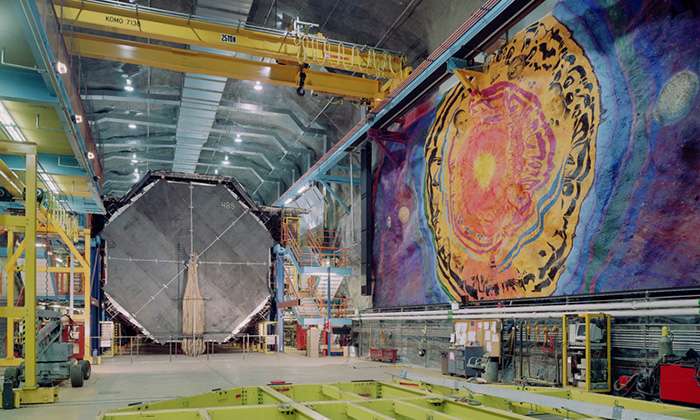As hunt for sterile neutrino continues, mystery deepens

Physicists have hypothesized the existence of fundamental particles called sterile neutrinos for decades and a couple of experiments have even caught possible hints of them. However, according to new results from two major international consortia, the chances that these indications were right and that these particles actually exist are now much slimmer.
In the 1990s, particle physicists at Los Alamos National Laboratory noticed something puzzling in one of their experiments. Their results disagreed with other experiments that discovered neutrino oscillations—the surprising ability of neutrinos to morph from one flavor to another—and ultimately led to last year's Nobel Prize for physics. An experiment at Fermi National Accelerator Laboratory (Fermilab) that was designed to confirm or refute the results from Los Alamos only added to the mystery by producing mixed results.
To resolve the disagreement, theorists proposed the existence of an as-yet-undiscovered fundamental particle—a sterile neutrino. Physicists speculated that the hypothesized particles might hold a key to better understanding of the evolution of the universe and why it is mostly made of matter and not antimatter.
Based on the Los Alamos and Fermilab results, scientists predicted a range of possible physical properties, such as mass, that sterile neutrinos could have. Several large research projects have been hunting for the elusive particles within that range.
Now in this latest study, by combining results from a different experiment at Fermilab, called the Main Injector Neutrino Oscillation Search (MINOS), and another in China, called the Daya Bay Reactor Neutrino Experiment, scientists have ruled out a large portion of the range of possible properties the hypothesized particles were predicted to be hiding in.
"So the plot thickens," says Karol Lang, a professor of physics at The University of Texas at Austin and co-spokesperson for the MINOS experiment. "But it's still possible that new experiments being developed at Fermilab might reveal some exciting new physics to explain these very different results."
The results are being published this week as three separate letters in the journal Physical Review Letters (see links below).
A team of researchers from UT Austin played many roles in producing the MINOS results, including graduate students Dung Phan, Simon De Rijck and Tom Carroll, and postdoctoral fellows Adam Schreckenberger, Will Flanagan and Paul Sail.
"It is very exciting to work on one of the pioneering experiments and have such a big impact on the field," says De Rijck.
Neither the MINOS nor Daya Bay results alone could be directly compared to the Los Alamos measurements, but combined, they could.
"It's not common for two major neutrino experiments to work together this closely," says Adam Aurisano of the University of Cincinnati, one of the MINOS scientists.
A resolution to the mystery of sterile neutrinos might come soon. Researchers in Fermilab's Short-Baseline Neutrino Program have already begun collecting data specifically targeting particles in the narrow mass range where sterile neutrinos might yet be hiding. Meanwhile, Lang and his colleagues in MINOS and Daya Bay have more data that they plan to analyze in the coming year, which might narrow the possible range of physical properties even further.
"A sterile neutrino, if found, would be a game changer for particle physics," says Phan.
More information: P. Adamson et al. Limits on Active to Sterile Neutrino Oscillations from Disappearance Searches in the MINOS, Daya Bay, and Bugey-3 Experiments, Physical Review Letters (2016). DOI: 10.1103/PhysRevLett.117.151801
F. P. An et al. Improved Search for a Light Sterile Neutrino with the Full Configuration of the Daya Bay Experiment, Physical Review Letters (2016). DOI: 10.1103/PhysRevLett.117.151802
P. Adamson et al. Search for Sterile Neutrinos Mixing with Muon Neutrinos in MINOS, Physical Review Letters (2016). DOI: 10.1103/PhysRevLett.117.151803
Journal information: Physical Review Letters





















